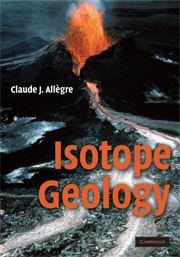Book contents
- Frontmatter
- Contents
- Preface
- Acknowledgments
- Isotopes and radioactivity
- The principles of radioactive dating
- Radiometric dating methods
- Cosmogenic isotopes
- Uncertainties and results of radiometric dating
- Radiogenic isotope geochemistry
- Stable isotope geochemistry
- Isotope geology and dynamic systems analysis
- References
- Appendix
- Further reading
- Solutions to problems
- Index of Names
- Subject Index
Uncertainties and results of radiometric dating
Published online by Cambridge University Press: 05 June 2012
- Frontmatter
- Contents
- Preface
- Acknowledgments
- Isotopes and radioactivity
- The principles of radioactive dating
- Radiometric dating methods
- Cosmogenic isotopes
- Uncertainties and results of radiometric dating
- Radiogenic isotope geochemistry
- Stable isotope geochemistry
- Isotope geology and dynamic systems analysis
- References
- Appendix
- Further reading
- Solutions to problems
- Index of Names
- Subject Index
Summary
Introduction
The purpose of this chapter is to review radiometric dating methods as applied both to terrestrial and to cosmic problems. We shall speak of the major results that now fix the chronological framework of the Earth's history, not forgetting that what they mean is inseparable from how reliable they are. The central question we shall be dealing with in this chapter is: how reliable are the geological ages we determine? In other words, what is the level of uncertainty affecting an age determination? What guarantee have we that this age is geologically meaningful?
Ascertaining the uncertainty Δ, when we obtain a value T, allowing us to write that the age is T ± Δ, is a problem that breaks down into various sub-problems, some of which are uncommon even in books on uncertainty. Let us get our ideas straight with a simple example.
Suppose we measure a series of rocks by the 87Rb–87Sr method and the analytical results are just about aligned on the (87Sr/86Sr, 87Rb/86Sr) diagram. How can we measure the slope of the straight line isochron to calculate the age of the rocks? Any experimental physicist will tell you that you first need to know the uncertainty affecting each individual physical measurement: the strontium isotope ratios and the absolute values in 87Rb and 86Sr. And then that you need to estimate the slope of the straight line by using the least-squares method where the “weight” of each data point is measured by its individual uncertainty.
- Type
- Chapter
- Information
- Isotope Geology , pp. 153 - 219Publisher: Cambridge University PressPrint publication year: 2008



